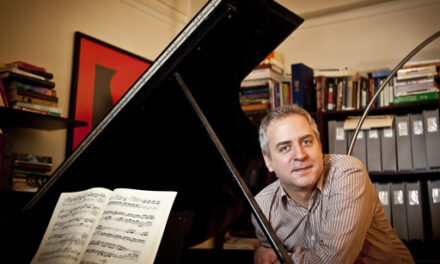Continuing a season that has predominantly featured female creative leaders in the areas of music, dance, and art, Carolina Performing Arts‘ production of The Day combines all three mediums. The creation of cellist and producer Maya Beiser, dancer Wendy Whelan (known for her work as a principal dancer of the NYC ballet and also worldwide), and composer David Lang, the day is so multidimensional that it is sometimes overwhelming fully to process and “unravel.” It is hard to describe this work without first mentioning all the music, movement, and design elements that came together to forge it. Aside from the live components of dance and cello, there were pre-recorded sounds (dialogue and multi-track cello) created by Beiser, who performed in seamless tandem with her earlier recordings. There were set elements, props used with Lucinda Childs‘ choreography executed by Whelan, projected visuals in the background, and ethereal lighting connecting visuals and sound.
Not to mention the work’s impetus – the second half of this performance, world to come, was composed in September 2001 against the backdrop of turmoil in New York City and the United States. Despite this, the piece does not come close to telling the audience how to feel but is instead a quicksilver meditation. The first half was composed as a prequel in 2016. Also entitled the day, the piece is full of sharp angles visual and auditory: leaps in the cello melody accentuated crisp lines in Whelan’s movement as she created shapes with fabric bands and thin rods. Hovering over everything is Lang’s crowd-sourced compilation of statements finishing the sentence “I remember the day….” Encompassing four pages of printed text, the rhythmic consistency of Beiser’s speaking voice was mesmerizing, almost trance-like, as her cello music became more layered and fervent. The piece ends in a visually similar fashion to how it began – Whelan and Beiser formed a spotlit, striking tableau against a video of them speaking, this time with stinging cello chords punctuating each statement.
In some ways the antithesis of the day, world to come is full of organic, flowing imagery. Whelan’s performance was gorgeous, unfolding and curving as if being led by something larger than herself. But this beauty had a darker side, perhaps implied by chilling tremolos in the cello and a haunting repeated minor arpeggio throughout the music. In addition, Whelan and Beiser, dressed in black instead of white and placed in opposite onstage positions from the day, performed in front of chilling and dramatic imagery. Projected slow-motion footage of a cello crashing down and breaking apart created tension, hauntingly released with visuals of fog and the sound of rain. Further dissipating tension, at times spotlights threw shadows and light on the ceiling above the audience, creating an enveloping, atmospheric effect in the house. The piece ended with this feeling, too, with Whelan wrapped in silky white fabric as the music rolled to a close. While some audience members could have focused on this piece’s tragic inspiration, this art is too mutable and thus is perfect for personal meditation. In this way, the day accomplished the creators’ goal of a reflection on humanity.












